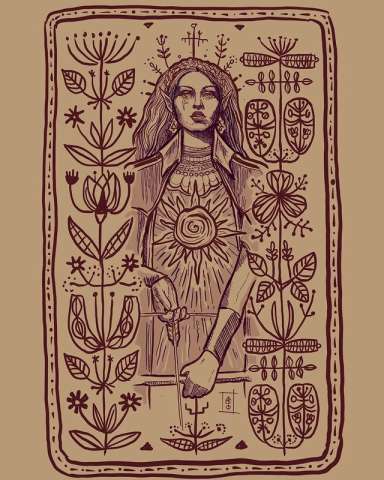Rarely mentioned in Old Norse texts and mythology in general, Alfheim was one of the Nine Realms of Norse cosmology. This delightful world of light and fertility was the dwelling place of the light (or bright) elves.
Alfheim stands in the heavens, high in the crown of the world tree Yggdrasil, not far from Asgard and Vanaheim. Although the realm is not described clearly in Norse literature, considering the nature of the elves – it is thought to be quite enchanting.
In the 13th century, Icelandic mythographer Snorri Sturluson (1179-1241) described the Light Elves as luminous and more beautiful than the sun, so we may suppose that their homeland was a gracious realm of light and beauty.
Etymology
The name Alfheim (Old Norse: Álfheimr) derives from the Old Norse words for “elf” and “home” and meaning – the home of the elves. It is also called Ljósálfheimr, which has a more concrete meaning – home of the light elves.
Alfheim in Old Norse texts
As the dwelling place of the elves, Alfheim is only mentioned twice in Old Norse texts. In one of the well-known mythological poems of the Poetic Edda – Grímnismál, stanza 5 begins with these verses:
Ydalir call they | the place where Ull
A hall for himself hath set;
And Alfheim the gods | to Freyr once gave
As a tooth-gift in ancient times.
Sturluson described the elvish realm in Gylfaginning (The Fooling of Gylfi) – the first part of Prose Edda (chapter 31):
Many places are there, and glorious. That which is called Álfheimr is one, where dwell the peoples called Light-Elves; but the Dark-Elves dwell down in the earth, and they are unlike in appearance, but by far more unlike in nature. The Light-Elves are fairer to look upon than the sun, but the Dark-Elves are blacker than pitch.
The Dwellers of Alfheim
Magical beings known as Light elves (Old Norse – álfr) are the inhabitants of Alfheim. Those bright, beautiful, and luminous beings inspired the arts, music, and creativity in general.
There are two contrasting types of elves in Norse mythology: light elves (Ljósálfar) and black elves (Dökkálfar). The dark ones dwell within the earth and have darker pigmentation, as the light (or bright) elves are “fairer to look upon than the sun,” as Sturluson described them. Their exalted position in mythology manifests by constant connection with gods in Old Norse poetry, particularly the Vanir.

Light Elves (Ljósálfar)
Light elves are powerful and magical beings that radiate light and purity around their existence. They are often associated with gods and humans, with whom they participate in various affairs. They are loved, but at the same time, many fear their powers and magic, which is why everyone respects them.
Also, LightEelves have very ambivalent relations with humans. They were commonly the ones who were causing human illnesses, but they also had the power to heal them in exchange for a suitable sacrifice. According to some sagas (Þiðreks saga, Hrólfs saga kraka), humans and elves could interbreed and have half-human, half-elfin children – that would often have an anthropomorphic appearance and possess exceptionally intuitive and magical powers.
Black Elves (Dökkálfar)
Since the sources portray Alfheim as the home of the light elves, as its other name Ljósálfheimr suggests, the actual position of the dark elves in Norse mythology stays uncertain to some point. Old texts describe how they live below or within the earth and are darker-skinned and uglier than light elves.
This description represents them more or less like dwarves – prominent craftsmen of Norse cosmology who mostly live in underground huts where they forge important mythological artifacts. Many historians support the point of view that dark elves are the same as dwarves, just called differently in various lore. Personally I also believe this is the case.
The Role of Alfheim in Norse Cosmology
Preserved sources that documented something about Alfheim are indeed deficient, but they give this realm a small but intriguing place in the overall mythology.
Its role is hugely associated with peace, beauty, harmony, fertility, and love. Meaning: this realm was on a large scale circumvented by the constant clashes between Asgard and Jotunheim.
Is There A Place On Earth Where Alfheim Could Be Located?
American scholar John Lindow, professor Emeritus of Old Norse and Folklore, even placed Alfheim geographically in some of his claims (Lindow, J. Norse Mythology: A Guide to the Gods, Heroes, Rituals, and Beliefs). He and other modern scholars noted that it could be the area between estuaries of the rivers Göta and Glomma, at the border of Sweden and Norway.
People living in this region are considered “fairer” than others. That’s what made the ancient people of Scandinavia think of this land as Alfheim. Although – according to these claims, the mythical land of light was inspired by this region – these claims are still the subject of debate by other academics.
The Mutual Story of Freyr and Alfheim

It has already been mentioned that the elves in Norse folklore are constantly intertwined with the Vanir gods. Although these links are not fully understood, one emerges as a constant in the Eddas. What could bring Alfheim and the Vanir together? The answer lies in one god – Freyr.
Ruler of the Elvish Land
Alfheim, the realm of the light elves, was ruled by Freyr – god of fertility and prosperity, connected with harvests, rain, and sunshine – which suggests a deep association with the magic of Vanir gods. Freyr is the son of the sea god Njörd and the twin brother of Freyja, the best-known and most important goddess in Norse mythology.
In all his glory, he was one of the most widely honored deities in the Norse pantheon. Old poem Lokasenna from Poetic Edda sings about him as “the foremost of the gods” and “hated by none”. His abilities reach far beyond the domain of fertility and expand to his bravery on the battlefield, even during Ragnarök when he dies in the battle with the fire giant Surtr, whose flaming sword burns down the world at the very end.
The reasons why he was such a beloved divinity aren’t hard to understand. In the Viking Age, people mainly lived from agriculture, so Freyr’s affection was necessary for fertile fields. Therefore it’s not surprising that many sacrifices on various occasions – harvest celebrations, festivals, weddings, and such – were addressed to him.
Mystery between Freyr and Alfheim
Historians and scholars have been puzzled for a long time over Freyr’s role as a ruler of Alfheim, but unfortunately, there aren’t many satisfying conclusions regarding this question. The real connection between Freyr and the elves was never fully explained – he was a Vanir god, not an elf, despite ruling their realm.
According to some myths, the realm of the elves was given to Freyr when he was a child, as a present from the Aesir gods for the appearance of his first tooth. This old custom still lives in Iceland and is called “tooth fee” (Old Norse Tann-fé). Other myths tell that Freyr was one of the hostages sent from Vanaheim to Asgard after the war between the Aesir and Vanir gods. After that, he became the ruler of Alfheim.
Circularity in Viking Stories
This may lead us to the conclusion that the events in Norse mythology are not always chronological. Sources from myths, sagas, prose, and poetry demonstrate the Viking way of storytelling as not always linear, but more circular.
A good example of that circular way of thinking and explaining things is one of the most important events in Norse cosmology – Ragnarök. In some interpretations, this apocalyptic battle isn’t the end of everything but a resurrection of the world.
FAQs about Alfheim
Vanir god Freyr lives in Alfheim. He is the ruler of this realm, home of the elves. His divinity is associated with fertility and prosperity, but he is also connected with harvests, rain, and sunshine.
Alfheim – an abode of elves – is located in the heavens, in the highest branches of the world tree Yggdrasil. It stands close to Asgard, home of the Aesir gods, and Vanaheim, home of the Vanir gods. Although this realm is not described as much in Norse literature, it is thought to be quite enchanting.
Famous Icelandic historian Snorri Sturluson (1179-1241) described the elves as luminous and more beautiful than the sun. According to this, we may suppose that their homeland Alfheim was a gracious realm of light and beauty.
In Norse mythology, Alfheim is the home of the elves. This delightful realm is a dwelling place of the light (or bright) elves. Those bright, beautiful, and luminous beings inspired the arts, music, and creativity in general.
No, Alfheim is not in Asgard. Alfheim, like Asgard, is one of the Nine Realms of Norse cosmology. It is placed near Asgard, on the heavenly branches of the world tree Yggdrasil.
Featured Image Credit: August Malmström, Public domain, via Wikimedia Commons

There is text saying Ullr visited Alfheim. Also the region Bohuslän used to be called Alfheim. Very good text anyway I just wanted to add this.
Hej Ullrica, thanks for reaching out! I have to look for a mention of Ullr in Alfheim and I had no idea Bohuslän was called Alfheim, will add something about that as well. I think it sort of points to how many actual places, and to some regard people, were tied back into their mythology at the time. Thanks for your kind comment and great feedback!